Whippet
 Whippet
Whippet
The Whippet is a modern, versatile, muscular and athletic breed. But they are also sweet natured, playful and responsive with people. They love to live indoors, their handy size and short coat making them an ideal pet for modern society. However, it is important to remember that being a Sight Hound, they must be well exercised and will take every opportunity to do so.
History of the Whippet
 Whippets 1725
Whippets 1725
Small Greyhound type dogs have existed for Centuries as evidenced by various authors and works of art dating back to the 1700's. In both size and shape, the Whippet is halfway between the Italian Greyhound and the Greyhound. So although more modern than either of these two breeds, he was always popular for catching small game like rabbits and is often referred to as 'the working-man's Hound'.
In 1575, Caius wrote about a Hound that is 'the middle kind betwixt the Harrier and the Greyhound that is swift running, follows the game with eagerness and taketh the prey with a jolly quickness'[1].
There are two theories about the origin of this 'middle kind' of swift running Sight Hound. The first is that it was simply bred down from Greyhounds over several centuries. Certainly there are several works of art from the 1700's like the painting on the left above, that back up this theory.
 Whippet and Greyhound 1900
Whippet and Greyhound 1900
But as catching or poaching rabbits was often a necessity to provide food for the working class man, small dogs of Greyhound type similar to the one on the right, were used. So the second theory is that the Whippet was developed by the coal-miners of Northern England around the late 1800's and early 1900's, using Greyhounds crossed with other breeds, often Terriers. This cross produced what became known as 'the working man's Greyhound'. Then, the sport of coursing rabbits was born.
Whippet and 'Rag' Racing
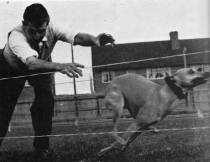 Whippet thrown into its stride
Whippet thrown into its stride
When 'Public Houses' or 'Pubs' became popular around the late 1800's and early 1900's, they attracted patrons with cheap beer and a means to place bets. Often in conjunction with these, tracks were set up for rabbit coursing. Wild rabbits that had previously been netted in the field were brought live to the 'Pub'. Participating dogs were recorded in a ledger, two by two, forming a knockout competition. Dogs were handicapped according to their starting positions.
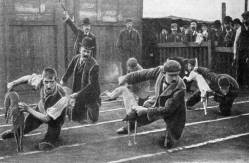 Whippets held by Neck and Tail
Whippets held by Neck and Tail
When all was ready, the 'slipper' (or handler of the dog) would kneel on one knee, holding his dog by the scruff of the neck and root of the tail as demonstrated on the left. When the 'starter' gave the word, the rabbit would be let loose at a particular spot, a predetermined distance from the competitors. When the starter was satisfied the rabbit was in full flight, he would fire a pistol. Then the 'slipper' would release his dog. An experienced 'slipper' would throw his dog several yards up the course so it landed perfectly in its stride and did not falter as demonstrated above. This required skill, judgement and the anticipation of which way the rabbit might run!
 Whippets Race Begins
Whippets Race Begins
When rabbit coursing with live rabbits became politically incorrect, a rabbit skin or piece of rag was used instead of a live rabbit. So, the sport called 'Rag' Racing, was born. This was conducted in a similar way to the live rabbit coursing described above. But instead of one handler there would be two handlers for each dog. One would release the dog and the other would be at the opposite end of the course, waving the 'rag' and yelling encouragement to their dog[5].
The Whippet becomes a Pure Breed
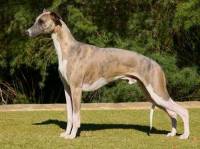 Modern Whippet
Modern Whippet
Compared to the Greyhound and the Italian Greyhound, historically the Whippet is a relatively new type of dog. But as the Kennel Club (UK) recognized it as such as early as 1890, it is quite an old pure breed. This is because in 1899, just 9 years after it was recognized by the Kennel Club, the Whippet Club (England) was formed to write the Breed Standard which was in turn approved by the Kennel Club. So as the Whippet Club was one of the earliest Breed Specialist Clubs to take charge of the breed, writing a Whippet Breed Standard and approving breed specialist judges, making the Whippet is one of the earliest pure breeds[2].
History of Whippets in Australia
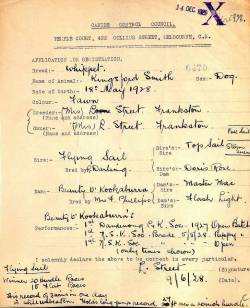 Whippet Pedigree Victoria 1928
Whippet Pedigree Victoria 1928
Whippet racing was first recorded in Australia in 1869, presumably along with the Sport of Coursing. When pedigrees began in Victoria, Whippets were recorded from 1923 and are now housed in our VCA Library. The one attached from 1928 is particularly interesting in that it also records the Whippet's Race Record. At that time there was a very active Victorian Whippet Racing Club.
But as far as pure breed Whippets are concerned, according to early Melbourne Royal Show catalogues, 'Caplin Bartic Whippets' were here by 1948 when 8 were entered in the Royal Melbourne Show of that year.
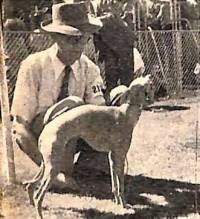 BIS Brisbane Royal 1951
BIS Brisbane Royal 1951
In 1951 Ch Caplin Bartic Coquette (pictured) won Best in Show at the Brisbane Royal. A son of his, Ch Flashing Cyclone was also a regular Best in Show winner prior to establishing the Amserham Kennels of I Payne and J Karas in NSW. Another early kennel was Miss Waddell's Waddellie Kennels of Inverell in Northern NSW, who imported Eng Ch Playmate of Allways followed by another 8 Whippets. By 1962 the Martinique partnership of Doherty and Crowley was founded, based on these existing lines. Martinique had a great influence on Australian Whippets, inspiring lots of established Hound exhibitors to progress Whippets in Australia[4].
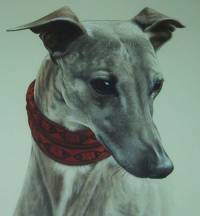 Australian Whippet
Australian Whippet
Numerous outstanding imports arrived here by boat before the 1970's. Then air travel became possible. So, instead of enduring months at sea, dogs could travel here in just a few days. However, a big deterrent was the quarantine period of up to 6 months which remained 'the norm' until the last decade or so. Many excellent breeders not only brought out beautiful Whippets, had also they had the knowledge to selectively breed them. It is beyond the scope of this website to name all the talented Whippet breeders we now have in this country. Suffice to say, Australian Whippets can successfully compete with Whippets bred anywhere else in the world[3].
Comparison between Italian Greyhound, Whippet and Greyhound
An excellent way to understand the Whippet is by comparing him to his closest relatives, the Italian Greyhound and the Greyhound. The obvious differences are their gait, size and length of leg. The Italian Greyhound has proportionately the longest length of leg of these three breeds, the Whippet is more 'square' and the Greyhound has a body longer than height at withers. There are also some minor differences which makes the following comparison table interesting.
| Italian Greyhound | Whippet | Greyhound | |
|---|---|---|---|
| Size | Ideal height is 32-38 cms (12.5-15ins). Ideally weight is 3.6-4.5 kg (8-10 lbs) but overall type and elegance is essential. |
Desirable height is dogs 47-51 cms (18.5 - 20 ins) with bitches 44-47 cms (17.5 - 18.5 ins). |
Ideal Height is dogs 71-76 cms (28-30 ins) with bitches being 69-71 cms (27-28 ins) |
 Italian Greyhound Italian Greyhound |
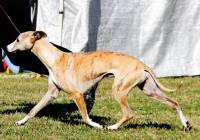 Whippet Whippet |
 Greyhound Greyhound |
|
| Gait | The Italian Greyhound has a unique high stepping action as described above. Never-the-less it should be free with the front and hind legs moving forward in a straight line with great propulsion (but not high stepping) action from the rear. | The Whippet should move with long, easy strides with great freedom, whilst holding its topline. Its forelegs should be thrown forward, low over the ground and not high stepping. The hind legs should come well under the body giving great propulsion from the rear. | The Greyhound should have a straight, low reaching, free stride enabling it to cover the ground at great speed. The hind legs should come well under body giving it great propulsion from the rear. |
| Head | The long, flat and narrow skull ends with a slight stop. The muzzle is also long and fine, with a dark nose. | The long, flat, rather wide skull ends with with a slight stop. The muzzle is powerful with clean cut jaws. Nose is either black or corresponds to the coat colour. A butterfly nose is permissible in white or parti-coloured dogs. | The long, flat, moderate width skull ends with a slight stop. The jaws are powerful and well chiselled. |
| Eyes |
The rather large eyes are bright and full of expression. |
The oval eyes are bright and full of expression. | The oval eyes are bright, intelligent, obliquely set and preferably dark. |
| Ears | The ears are placed well back, rose-shaped, soft and fine, but not pricked. |
The small ears are rose-shaped and fine in texture. |
The small ears are rose-shaped and fine in texture. |
| Mouth | Jaws strong with a complete scissor bite | Jaws strong with a complete scissor bite | Jaws strong with a complete scissor bite, |
 Italian Greyhound Italian Greyhound |
 Whippet Whippet |
 Greyhound Greyhound |
|
| Neck | The neck is long and gracefully arched. | The neck is long, muscular and elegantly arched. | The neck is long, muscular and elegantly arched. It is well let into shoulders. |
| Forequarters | The shoulders are long and sloping. The forelegs, with their strong bone and pasterns should be straight and set well under the shoulders. | The shoulders are well laid back with flat muscles. There is moderate space between the shoulder blades and the chest is not too wide. When viewed in profile, the upper arm is approximately of equal in length to the shoulder blade and placed so that the elbow falls in a line directly under the withers. The moderately boned forelegs are straight and upright but the strong pasterns have a slight spring. | The shoulder blades are oblique and well set back. The shoulders are muscular without being loaded, and cleanly defined at the withers. The chest is narrow.The elbows are free and well set under shoulders. The forelegs are long and straight with good bone ending in moderately long and slightly sprung pasterns which should not incline either in or out. |
| Feet | Hare feet | Oval feet, well split between the toes | Compact feet with toes of moderate length |
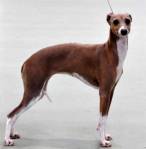 Italian Greyhound Italian Greyhound |
 Whippet Whippet |
 Greyhound Greyhound |
|
| Body | The deep chest is narrow but the ribcage and brisket are long. The back has a slight arch over the loin but there is much more arch and steeper croup than the Whippet or the Greyhound, causing the Italian Greyhound's high stepping front action. | The chest or brisket is very deep with well sprung ribs. The somewhat long back is broad, firm and well muscled, showing a graceful arch over the loin, but not humped. Instead, the loin should give the impression of strength and power. The underline has a definite tuck up. | The chest is deep and capacious, providing adequate heart room. The ribcage is deep, with well sprung ribs carried well back. The rather long back is broad and square with a powerful, slightly arched loin. In profile the flanks well cut up. |
| Hindquarters | The well muscled first and second thighs make the hind legs parallel when viewed from behind. The stifles should be well bent with the hocks well let down. | The well developed hindquarters are broad and strong across the first and second thighs. The stifles well bent without exaggeration, with hocks well let down, enabling the dog to stand naturally over a lot of ground. | The first and second thighs are wide and muscular, showing great propelling power. The stifles well bent and the hocks short, inclining neither in nor out. The body and hindquarters are well coupled together, enabling the dog to cover adequate ground when standing. |
| Tail | The long, fine tail is low set and carried low. | The long, tapering tail should reach at least to the hock. When moving it should be carried in a delicate curve not higher then the back. | The long tail is set and carried rather low. It is strong at root tapering to point and slightly curved. |
| Coat | The skin of an Italian Greyhound should be fine and supple while the hair is short, fine and glossy. | The coat of a Whippet should be fine, short and close in texture. | The coat of a Greyhound should be fine and close. |
| Colour | The Italian Greyhound can be black, blue, cream, fawn, red, white, or any of these colours broken with white. White dogs may be broken with one of these colours. The only unacceptable colours are black or blue with tan markings, or brindle. | The Whippet may be any colour or mixture of colours, except merle. |
The Greyhound may be black, white, red, blue, fawn, fallow, brindle or any of these colours broken with white. |
References and Further Reading
- Published as 'Whippet Racing' in Dog News Australia (Top Dog Media Pty Ltd Austral NSW) July 2020, Page 12
[1] Dr John Caius, "Of Englishe Dogges: The Diuersities, the Names, the Natures, and the Properties", London, 1576, translated into English by Abraham Fleming, Section 1 the 'Leviner' Page 15. The work was originally published in Latin in 1570 as "Johannes Caius, De Canibus Britannicis".Caius Section 1 the Leviner Page 15
[2] E.G.Walsh and Mary Lowe, 'The English Whippet' Published by Boydell Press Ltd, Suffolk IP12 3DF ISBN 0-85115-193-0 Chapter 2, 'The Pure-bred Whippet' Pages 19 - 20
[3] Frank Pieterse, 'The History of Purebred Dogs in Australia' published by OzDog Newspaper 1997. The Whippet Page 305-307
[4] Bo Bengston, 'The Whippet' Published by Kennel Club Books, Freehold NJ USA ISBN 978-1-59378-688-5. Chapter 6 Whippets 'Down Under' Page 141
[5] Brian Vesey-Fitzgerald, 'The Book of the Dog' Published by Nicholson & Watson, London 1948 Part 111 'Staffords and Baiting Sports' by Phil Drabble, Page 917